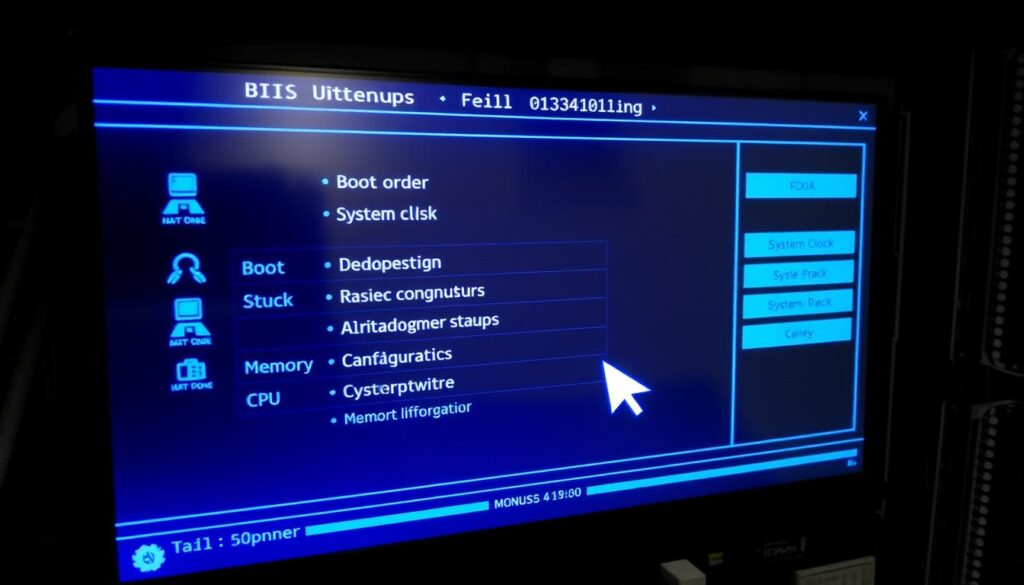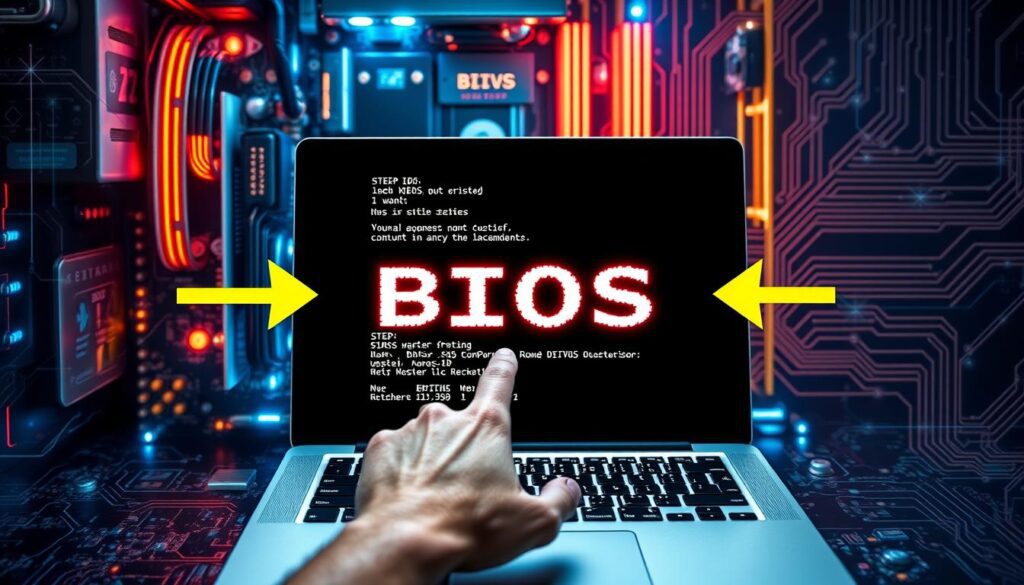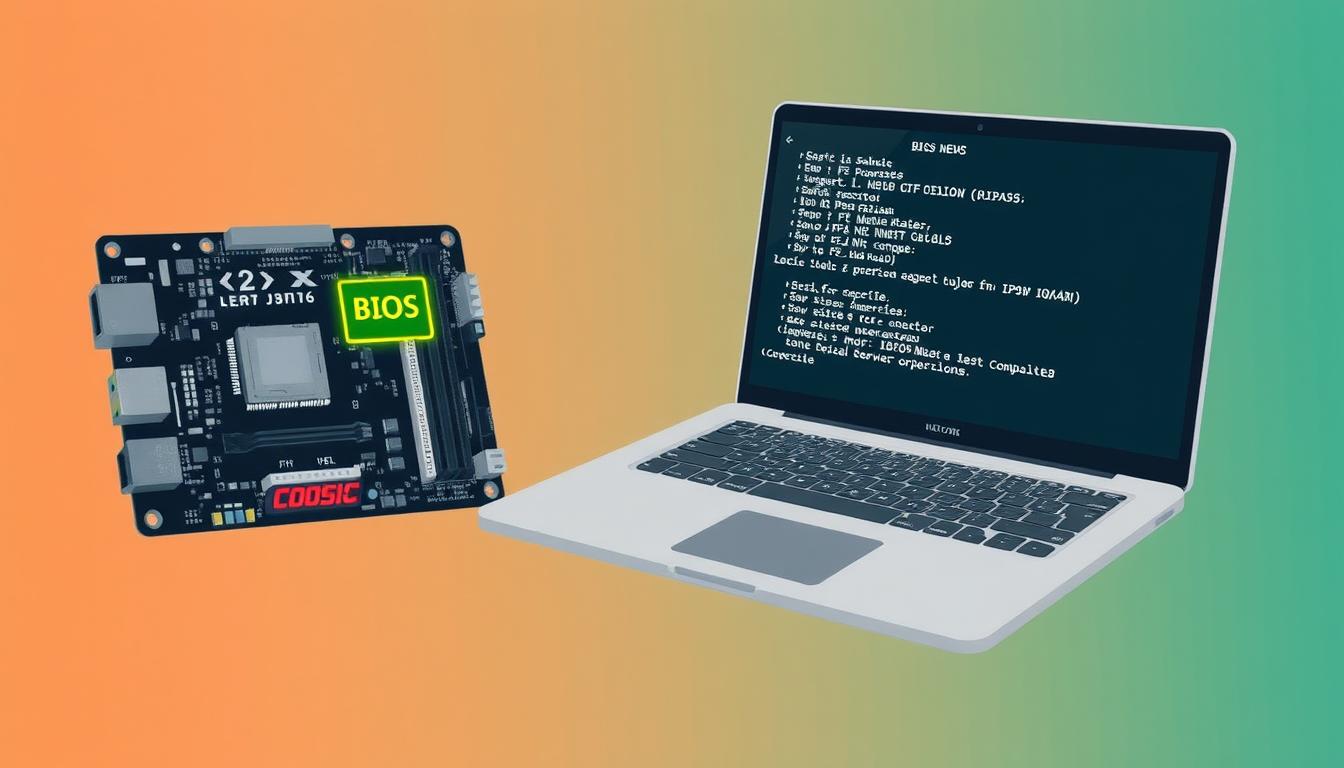How to access the BIOS. Getting into the BIOS can seem hard, but it’s key for tweaking your system. To get into the BIOS, you must follow certain steps. The key to enter the BIOS varies by computer maker. This article will guide you through accessing the BIOS, covering different methods for different systems.
Introduction to BIOS Access
Both novices and IT experts can use this information. It will demonstrate how to access the BIOS and its configuration. With the right info, you can boost your system’s speed, set up boot options, and fix common problems. You’ll learn how to use the BIOS entry key and follow the steps to access the BIOS.
Important Takeaways
- Learning how to access the bios is essential for customizing system settings
- Following the bios access steps is crucial for a successful bios entry
- The bios entry key varies by computer manufacturer
- Accessing the bios allows for system performance optimization
- Configuring boot options is possible through bios access
- Troubleshooting common issues is easier with bios access knowledge
Understanding BIOS Basics and Its Importance
Understanding the foundations of BIOS is key. The method the operating system converses with Hardware is governed by the of the Basic Input/Output System, or BIOS. By gaining access to the BIOS, users can modification the date, time, and boot sequence. Because of this, a bios setup guide is needed for navigating the bios menu.
To start accessing bios settings, knowing your BIOS type is essential. There are UEFI and traditional BIOS systems, each with unique features and limits. Knowing these differences helps users make better choices when setting up their systems.
- Boot order configuration
- Time and date settings
- Hardware configuration options
By grasping these basics and using a bios setup guide, users can easily navigate the bios menu access. This lets them make the right changes to boost their system’s performance.
How to Access the BIOS on Different Systems
To get into the bios boot menu, you need to enter bios mode. This can modification based on your creator of the system and model. Restarting your computer is the initial action in Windows 10. Next, hit the key, which is usually Del, F2, or F12.
Consult with your computer’s handbook to discover how to get access to the BIOS in Windows 10. Or visit the website of the maker.
Some common BIOS access keys by manufacturer include:
- Dell: F2 or F12
- HP: F10 or F12
- Lenovo: F2 or F12
You can also get into the BIOS through Windows 10 settings. Go to the Settings app, then click on Update & Security. Next, click on Recovery. After that, restart now and pick Troubleshoot, then Advanced options, and finally, UEFI Firmware Settings.
Fast boot can stop your computer from getting into the BIOS setup. To get into the BIOS with fast boot on, try disabling it in Windows 10 settings. Or, press the key repeatedly when starting up.
Common BIOS Settings You Should Know
When you enter the BIOS, you’ll see many settings to boost your system’s performance. A bios setup guide can help you understand these options. The boot order is key, deciding which devices your computer boots from first. You can also adjust the time and date and tweak settings for fans and USB ports.
It’s vital to set a BIOS password for security. If you forget it, you can reset it. Just follow the maker’s steps, which might involve pressing a key or using a tool.
Some common BIOS settings include:
- Boot order: Configure the order in which your computer boots from different devices.
- Time and date: Set the system clock and calendar.
- Hardware configurations: Configure fan settings, USB ports, and other hardware options.
Knowing these settings can make your system run better and safer. By using a bios setup guide and features like bios password reset, you keep your system efficient and secure.

Troubleshooting BIOS Access Problems
Getting into the BIOS can seem easy, but it’s not always the case. If standard keys don’t work or you’ve lost the BIOS password, it can be tough. Knowing the right bios access steps and bios entry key for your system is key.
When standard keys fail, try different keys or key combinations. You can also try accessing bios settings through Windows 10 settings or a bootable USB drive.

- Check the system manual or the manufacturer’s website for specific bios access steps and bios entry key combinations.
- Take a look at a different keyboard or USB port to examine hardware issues.
- Do a BIOS reset to its default configurations by taking out the CMOS battery or using a reset button.
You can quickly access the BIOS by using these pointers and being aware of the proper BIOS access procedures and entry key for your machine. Always back up your data before changing BIOS settings to prevent loss.
| Issue | Solution |
|---|---|
| Standard keys don’t work | Try alternative keys or combinations of keys |
| Forgotten BIOS password | Reset the BIOS to its default settings |
| Failed BIOS access | Try accessing BIOS through Windows 10 settings or using a bootable USB drive |
Final Thought
How to access the BIOS. For tech-savvy users, accessing and manipulating the BIOS is essential. You can adjust your system’s settings by consulting the BIOS setup guide. It performs better and reaches its maximum potential as a result.
Your computer’s BIOS is its fundamental component. Knowing how to use it lets you control your computing experience. It’s essential for customizing your system.
Whether you’re fixing hardware issues or tweaking settings, the BIOS has what you need. This guide will help you use the BIOS confidently. You’ll make choices that enhance your device’s efficiency and reliability.
So, go ahead and explore the BIOS. It’s incredibly customizable options. With the appropriate awareness, you’ll be able to release the complete potential of your system. Enjoy a expertise with computers adapted to your requirements.
FAQ
Why do I require access to BIOS, and Describe it.
Basic Input/Output System is what BIOS stands for. The operating system and hardware of your computer are connected via this firmware. By accessing BIOS, you can change settings like boot order and time. This helps make your system run better.
What can I find in my system’s BIOS?
How you access the BIOS depends on the model and brand of your computer. Common keys include F2, F10, Del, and Esc. You can also get to BIOS through Windows 10 Settings.
What kinds of BIOS systems are there?
Traditional BIOS and UEFI are the two primary BIOS varieties. UEFI is newer and has more features. Traditional BIOS is older but more common.
In the event that I forget my BIOS password, how can I reset it?
To reset your BIOS password, navigate to the BIOS menu and select Password Settings. If it does not function, contact the manufacturer or a specialist.
What should I do if I’m having problems getting into the BIOS?
Check that you’re using the correct key, turn off rapid boot if it’s enabled, and attempt safe mode or a BIOS recovery option if you’re having difficulties entering the BIOS.
What are some of the most common BIOS settings I should know?
Key BIOS settings include boot order, time, and date, and hardware settings. Knowing these can help you tweak your system for better performance and solve problems.







Thanks for sharing. I read many of your blog posts, cool, your blog is very good.